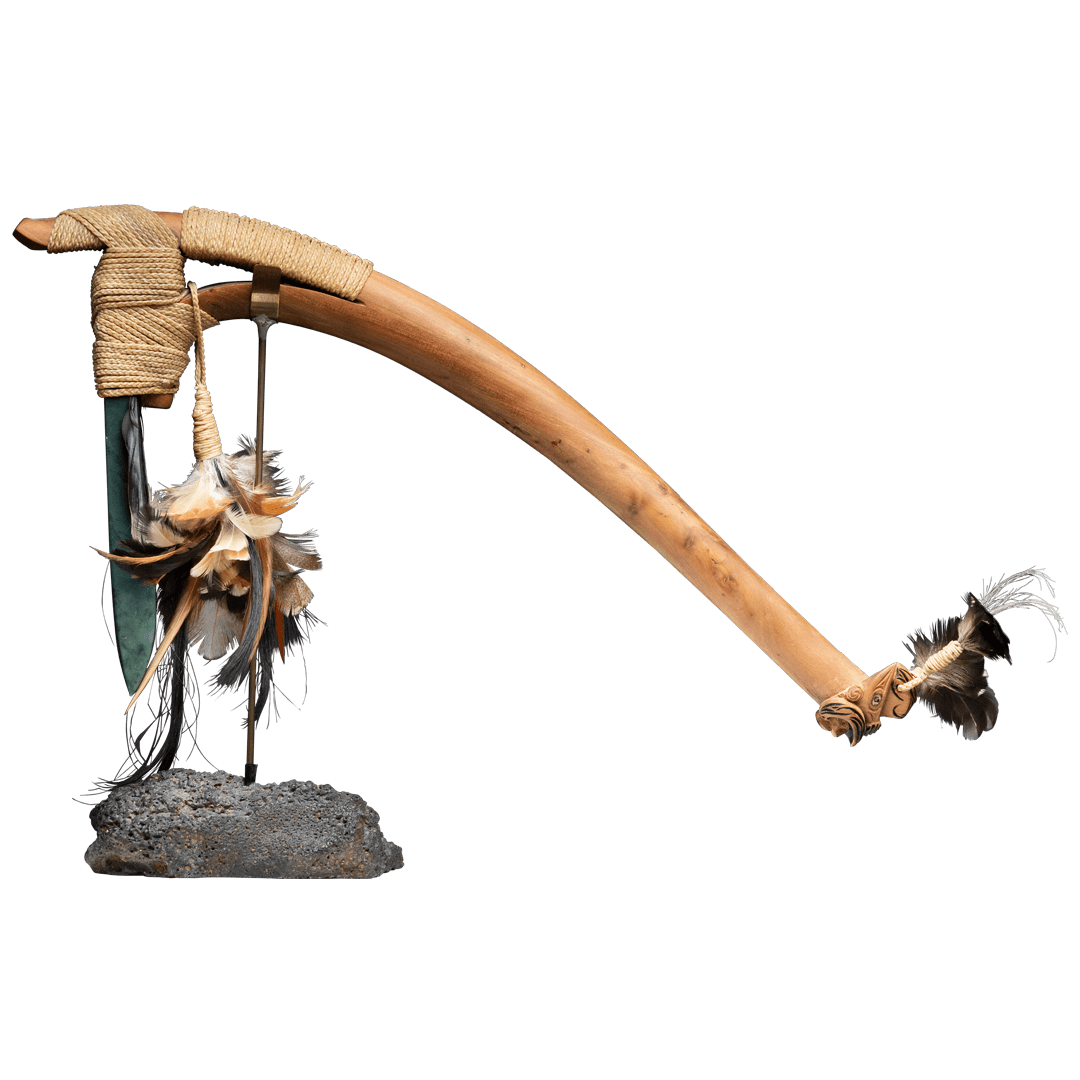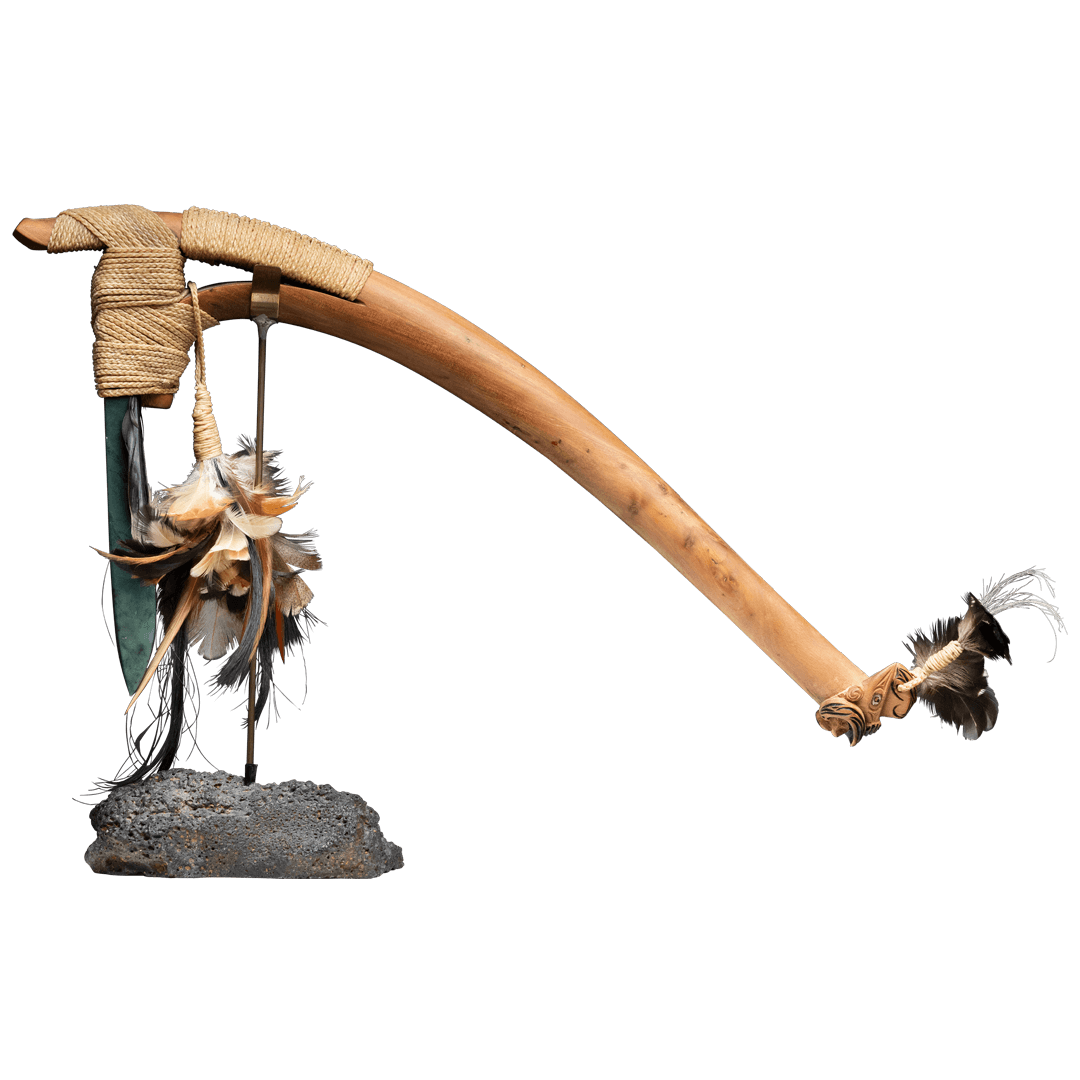
Native Art
Gordon Roi Hatfield (Maori)
For example, the "Toki poutangata" is a ceremonial ax made of greenstone that is attached to finely carved and detailed handles. Only persons with "mana", people of high rank and with great leadership qualities, are authorized to carry this weapon. In addition to the detailed handles, this artwork is also decorated with feathers of native birds. The beautiful object, made of various special materials, was created by the famous Maori artist Gordon Roi Hatfield.
Traditional Maori art was characterized by an integration of form and function. Objects were created to serve primarily a practical or symbolic purpose. They gave visual shape and form to cultural belief systems and expressed spiritual ideas in natural materials such as wood, stone, bone and flax. Preference was given to making an object from a single piece of material that largely determined the shape of a sculpture. Collaborative effort characterized the art-making process, although works of art produced by tohunga (expert practitioners) were highly prized.
The effects of European colonization changed the social and political role of the artist. The function of art changed from a primarily spiritual role to protest against change and an assertion of Maori identity and beliefs.
During the 1960s and 1970s, a strong revival of Maori nationalism and culture developed, alongside a growing political voice and demand for respect for the Treaty of Waitangi. The 1984 Te Maori Exhibition, which featured traditional Maori artwork and was displayed at the Metropolitan Museum of Art in New York, helped promote a greater appreciation of New Zealand's Maori art and culture.
Many young artists responded to their Maori heritage, urban situation and Western upbringing by producing works intended as a synthesis of Maori and European art forms and practices. In particular, they drew on the 'primitivism' and abstraction of European art, which made use of symbolic patterns and geometric design - also hallmarks of Maori art. Maori artists put their own spin on international modernism and experimented with the materials and techniques of Western art.
Although the media, techniques and often styles are derived from Western art, the subject matter, themes and motifs of the artworks reflect Maori belief systems and experiences. Artists affirmed Maori values ??and addressed social and political issues related to Maori in their work. Their efforts resulted in "hybrid" artworks that elicited mixed reactions. Some Maori traditionalists saw such works as sacrilegious. Other commentators believed they showed that Maori performers were dependent on and controlled by European culture.
The artworks below by Gordon Roi Hatfield (Maori) are available at
Traditional Maori art was characterized by an integration of form and function. Objects were created to serve primarily a practical or symbolic purpose. They gave visual shape and form to cultural belief systems and expressed spiritual ideas in natural materials such as wood, stone, bone and flax. Preference was given to making an object from a single piece of material that largely determined the shape of a sculpture. Collaborative effort characterized the art-making process, although works of art produced by tohunga (expert practitioners) were highly prized.
The effects of European colonization changed the social and political role of the artist. The function of art changed from a primarily spiritual role to protest against change and an assertion of Maori identity and beliefs.
During the 1960s and 1970s, a strong revival of Maori nationalism and culture developed, alongside a growing political voice and demand for respect for the Treaty of Waitangi. The 1984 Te Maori Exhibition, which featured traditional Maori artwork and was displayed at the Metropolitan Museum of Art in New York, helped promote a greater appreciation of New Zealand's Maori art and culture.
Many young artists responded to their Maori heritage, urban situation and Western upbringing by producing works intended as a synthesis of Maori and European art forms and practices. In particular, they drew on the 'primitivism' and abstraction of European art, which made use of symbolic patterns and geometric design - also hallmarks of Maori art. Maori artists put their own spin on international modernism and experimented with the materials and techniques of Western art.
Although the media, techniques and often styles are derived from Western art, the subject matter, themes and motifs of the artworks reflect Maori belief systems and experiences. Artists affirmed Maori values ??and addressed social and political issues related to Maori in their work. Their efforts resulted in "hybrid" artworks that elicited mixed reactions. Some Maori traditionalists saw such works as sacrilegious. Other commentators believed they showed that Maori performers were dependent on and controlled by European culture.
The artworks below by Gordon Roi Hatfield (Maori) are available at



